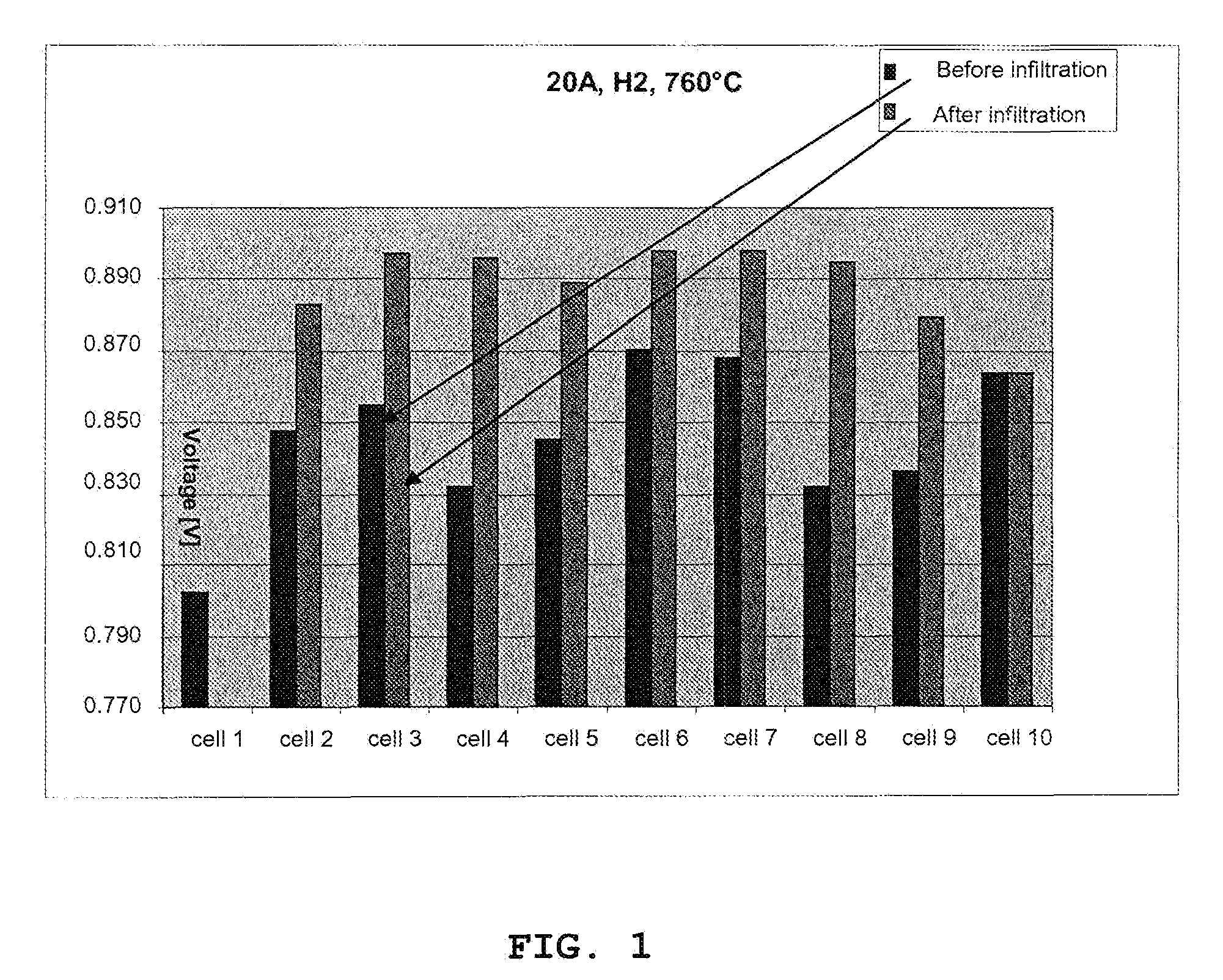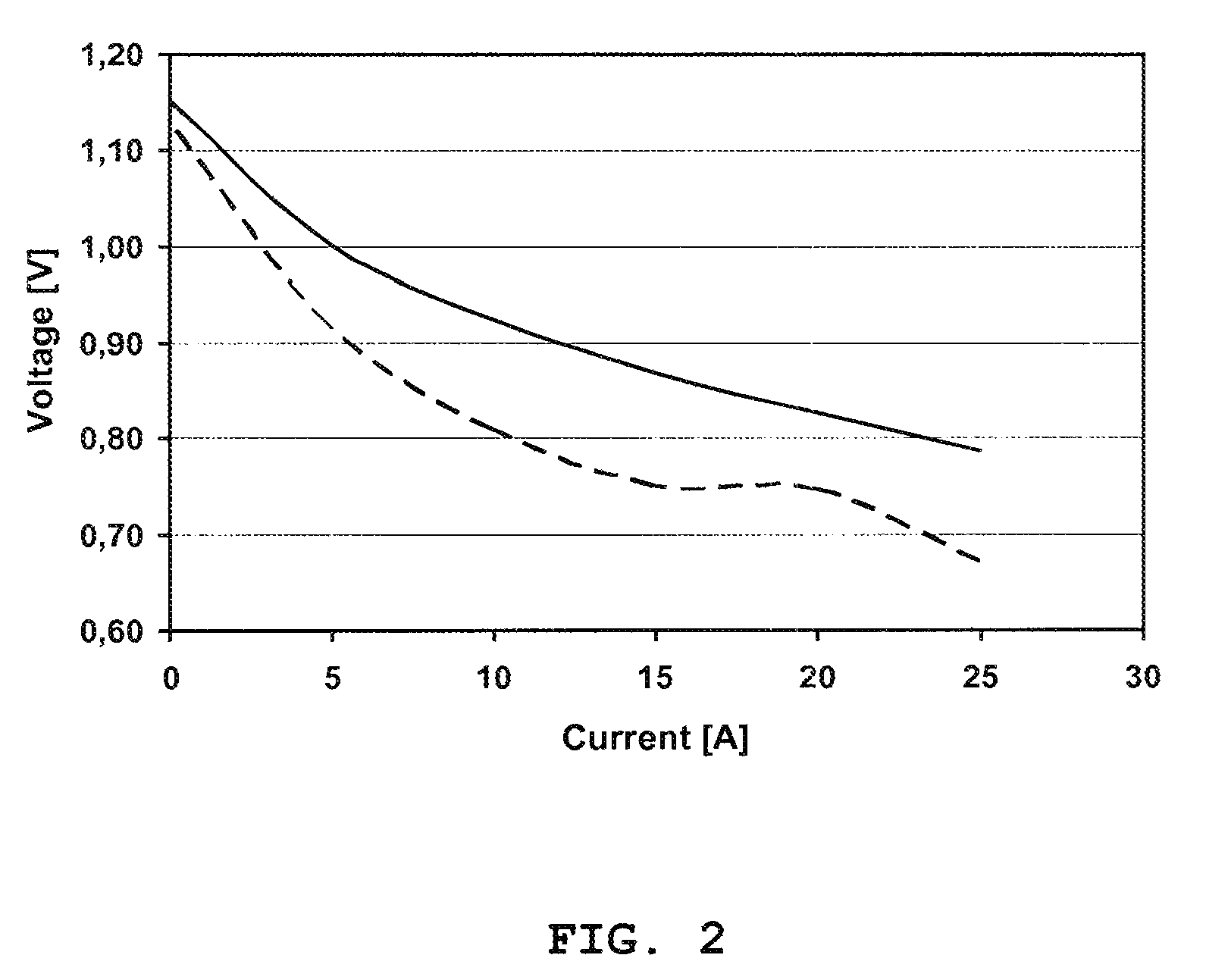Solid oxide cell stack and method for preparing same
a solid oxide cell and stack structure technology, applied in the direction of cell components, electrochemical generators, coatings, etc., can solve the problems of reducing the performance of the solid oxide cell stack structure, reducing the beneficial effect of the catalyst in the electrodes, and reducing the catalytic activity in the electrodes of the stack structure over time, so as to achieve less sensitive, simple, elegant and rather inexpensive, the effect of simple and simple procedur
- Summary
- Abstract
- Description
- Claims
- Application Information
AI Technical Summary
Benefits of technology
Problems solved by technology
Method used
Image
Examples
example 1
[0058]This example shows the performance in terms of voltage improvement of a solid oxide fuel cell structure at 760° C. The structure contains ten single cells and is prepared according to the invention where the cathode of the single solid oxide cells has been impregnated with a catalyst precursor after the stack has been assembled and initiated. The electrode layers of the single solid oxide cells have not been impregnated with a catalyst precursor before the stack is assembled and initiated, but contain the active material already in form of an Ni / YSZ anode and an LSM / YSZ cathode. In other words, the electrodes are already active.
[0059]After the assembling and the initiation (anode reduction), the cathode is impregnated with catalytic material (79% CeO2, 21% GdO11 / 2).
[0060]Appropriate amounts of the nitrate salts (here Ce-nitrate and Gd-nitrate) are dissolved in deionized water. A suitable surfactant (e.g. P123) is added with stirring. For the specific case the concentration was...
example 2
[0064]This example shows the performance in terms of voltage improvement of a solid oxide fuel cell structure at 680° C. The structure contains 10 single cells and is prepared according to the invention where the cathode of the single solid oxide cells has been impregnated with a catalyst precursor after the stack has been assembled and initiated. The electrode layers of the single solid oxide cells have not been impregnated with a catalyst precursor before the stack is assembled and initiated, but contain the active material already in form of an Ni / YSZ anode and an LSM / YSZ cathode. In other words, the electrodes are already active.
[0065]After the assembling and the initiation (anode reduction), the cathode is impregnated with catalytic material (79% CeO2, 21% GdO11 / 2).
[0066]The performance was measured in terms of voltage improvement of the cells of the stack at 0.22 A / cm2 and 680° C. In the anode: H2=150 l / h+N2=100 l / h and in the cathode air=960 l / h. FIG. 2 shows the voltage impr...
example 3
[0067]A 10 cell 12×12 cm stack based on anode supported cells with Ni / YSZ anodes and LSM / YSZ cathodes was assembled according to usual procedures. Some of the cells had been impregnated with a CGO precursors prior to the stack assembling right after the cathode firing. The electrical performance of these cells was indistinguishable from the electrical performance of those cells not impregnated. The stack was operated at ˜700° C. under a current load of 25 A while feeding 150 l / h H2 to the anode compartment. After about 400 hrs of operation, the stack operation was terminated and the stack cooled. After ˜30 days of storage under ambient conditions the stack was brought into operation again, but this time at a new site in a different laboratory. The initial performance was close to the one observed during the first test period, but after ˜100 hrs of operation the electrical performance of several cells started to degrade. After 1100 hrs of operation the stack was cooled down, and the ...
PUM
| Property | Measurement | Unit |
|---|---|---|
| temperatures | aaaaa | aaaaa |
| temperatures | aaaaa | aaaaa |
| particle diameter | aaaaa | aaaaa |
Abstract
Description
Claims
Application Information
 Login to View More
Login to View More - R&D
- Intellectual Property
- Life Sciences
- Materials
- Tech Scout
- Unparalleled Data Quality
- Higher Quality Content
- 60% Fewer Hallucinations
Browse by: Latest US Patents, China's latest patents, Technical Efficacy Thesaurus, Application Domain, Technology Topic, Popular Technical Reports.
© 2025 PatSnap. All rights reserved.Legal|Privacy policy|Modern Slavery Act Transparency Statement|Sitemap|About US| Contact US: help@patsnap.com



